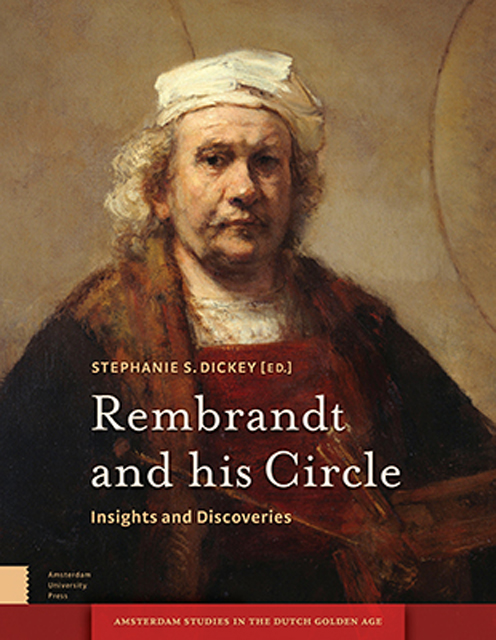Book contents
- Frontmatter
- Dedication
- Contents
- Acknowledgements
- Introduction
- 1 Rembrandt and Frans Hals Painting in the Workshop of Hendrick Uylenburgh
- 2 Rembrandt and the Germanic Style
- 3 Rembrandt and the Humanist Ideal of the Universal Painter
- 4 Curiosity and Desire: Rembrandt’s Collection as Historiographic Barometer
- 5 Painted Landscapes by Lievens and Rembrandt : The View from Seventeenth-Century Amsterdam Collections
- 6 Jan Lievens in Antwerp: Three Rediscovered Works
- 7 Gerrit Dou as a Pupil of Rembrandt
- 8 A New Painting by Jan van Noordt in Budapest
- 9 Rembrandt’s First Nude? The Recent Analysis of Susanna and the Elders from Rembrandt’s Workshop
- 10 Rembrandt’s Head of Christ: Some Technical Observations concerning Matters of Style
- 11 A Rediscovered Head of John the Baptist on a Platter from Rembrandt’s Studio
- 12 Rembrandt’s One Guilder Print: Value and Invention in ‘the most beautiful [print] that ever came from the burin of this Master’
- 13 Rembrandt, Ferdinand Bol, and Tobit: The Emergence of a Pathosträger
- 14 Biblical Iconography in the Graphic Work of Rembrandt’s Circle
- 15 Jan van Vliet and Rembrandt van Rijn: Their Collaboration Reassessed
- 16 Printmaking among Artists of the Rembrandt School
- 17 Chain Line Pattern Matching and Rembrandt’s Prints
- List of Illustrations
- Bibliography
- Index Nominum
5 - Painted Landscapes by Lievens and Rembrandt : The View from Seventeenth-Century Amsterdam Collections
Published online by Cambridge University Press: 21 January 2023
- Frontmatter
- Dedication
- Contents
- Acknowledgements
- Introduction
- 1 Rembrandt and Frans Hals Painting in the Workshop of Hendrick Uylenburgh
- 2 Rembrandt and the Germanic Style
- 3 Rembrandt and the Humanist Ideal of the Universal Painter
- 4 Curiosity and Desire: Rembrandt’s Collection as Historiographic Barometer
- 5 Painted Landscapes by Lievens and Rembrandt : The View from Seventeenth-Century Amsterdam Collections
- 6 Jan Lievens in Antwerp: Three Rediscovered Works
- 7 Gerrit Dou as a Pupil of Rembrandt
- 8 A New Painting by Jan van Noordt in Budapest
- 9 Rembrandt’s First Nude? The Recent Analysis of Susanna and the Elders from Rembrandt’s Workshop
- 10 Rembrandt’s Head of Christ: Some Technical Observations concerning Matters of Style
- 11 A Rediscovered Head of John the Baptist on a Platter from Rembrandt’s Studio
- 12 Rembrandt’s One Guilder Print: Value and Invention in ‘the most beautiful [print] that ever came from the burin of this Master’
- 13 Rembrandt, Ferdinand Bol, and Tobit: The Emergence of a Pathosträger
- 14 Biblical Iconography in the Graphic Work of Rembrandt’s Circle
- 15 Jan van Vliet and Rembrandt van Rijn: Their Collaboration Reassessed
- 16 Printmaking among Artists of the Rembrandt School
- 17 Chain Line Pattern Matching and Rembrandt’s Prints
- List of Illustrations
- Bibliography
- Index Nominum
Summary
Abstract
Around 1637–1638, Rembrandt van Rijn and Jan Lievens began to paint landscapes, the former in Amsterdam and the latter in Antwerp. When Lievens moved to Amsterdam in 1644, the two artists were again colleagues and competitors. This essay considers the role that this genre played in the artists’ production by investigating seventeenth-century Amsterdam inventories as a vehicle for the expression of market demand. In examining issues of price, size, subject matter, and ownership, this essay takes a preliminary step in assessing how each artist positioned these paintings, and himself as a landscapist, on the art market.
Keywords: Jan Lievens, Rembrandt van Rijn, landscape painting, inventories, Amsterdam
On 1 March 1644, Jan Lievens is recorded as having rented a room in the Amsterdam house of Jan Miense Molenaer. The circumstances prompting this document, however, are less than collegial: Lievens, having vacated the room, was appearing in court to reclaim an unfinished landscape that remained in his host's residence. Molenaer testified that he had purchased the pigments and panel that Lievens had used for the picture, and that he therefore had rightful claim to the painting. The court document specifies that the notary ordered Lievens to pay Molenaer 13 guilders in exchange for his painting. Given the lack of subsequent proceedings, Lievens must have paid his debt and received the picture. Unfortunately, the identification of the painting in dispute has been lost. For an artist who was living in Antwerp less than two months earlier, this incident offers great insight into Lievens's choices as he entered the Amsterdam market. It is remarkable that one of the first paintings that he executed in his new city of residence was a landscape, particularly as he had made a reputation for himself as a history and portrait painter, and also that the artist perceived the picture to be valuable enough to pursue in court. Furthermore, this is the earliest instance of a written reference to the artist as a painter of landscapes.
Lievens had only begun to paint independent landscapes in the late 1630s, about fifteen years after completing his apprenticeship with Pieter Lastman.
- Type
- Chapter
- Information
- Rembrandt and his CircleInsights and Discoveries, pp. 122 - 150Publisher: Amsterdam University PressPrint publication year: 2017



